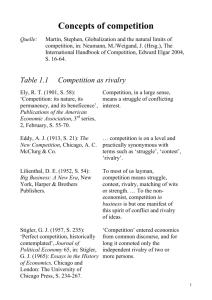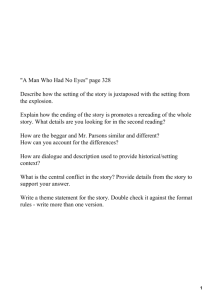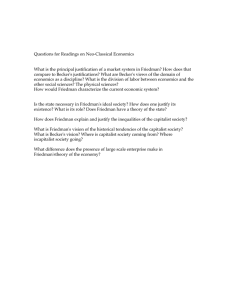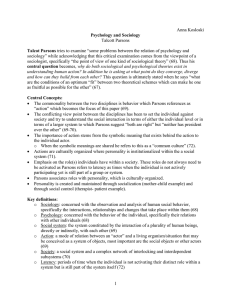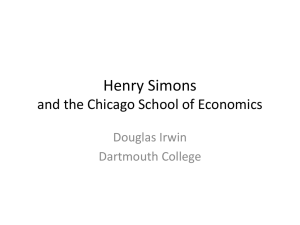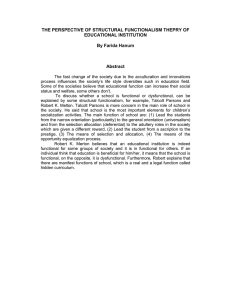“Every system of scientific theory involves philosophical assumptions” --Talcott Parsons
advertisement
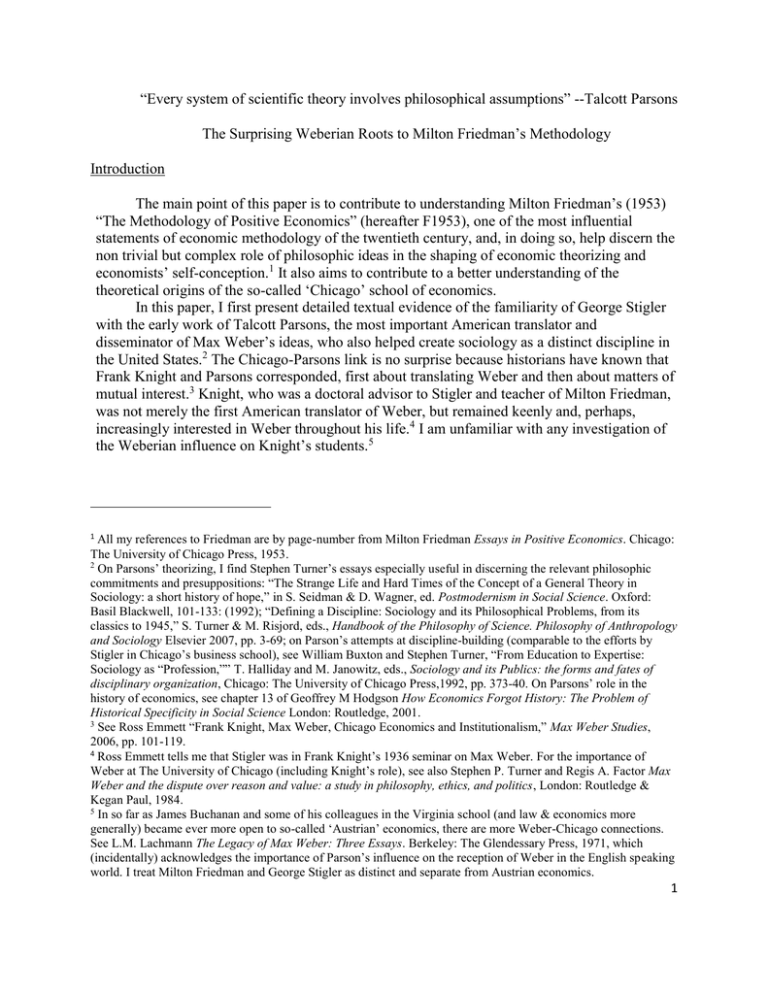
“Every system of scientific theory involves philosophical assumptions” --Talcott Parsons The Surprising Weberian Roots to Milton Friedman’s Methodology Introduction The main point of this paper is to contribute to understanding Milton Friedman’s (1953) “The Methodology of Positive Economics” (hereafter F1953), one of the most influential statements of economic methodology of the twentieth century, and, in doing so, help discern the non trivial but complex role of philosophic ideas in the shaping of economic theorizing and economists’ self-conception.1 It also aims to contribute to a better understanding of the theoretical origins of the so-called ‘Chicago’ school of economics. In this paper, I first present detailed textual evidence of the familiarity of George Stigler with the early work of Talcott Parsons, the most important American translator and disseminator of Max Weber’s ideas, who also helped create sociology as a distinct discipline in the United States.2 The Chicago-Parsons link is no surprise because historians have known that Frank Knight and Parsons corresponded, first about translating Weber and then about matters of mutual interest.3 Knight, who was a doctoral advisor to Stigler and teacher of Milton Friedman, was not merely the first American translator of Weber, but remained keenly and, perhaps, increasingly interested in Weber throughout his life.4 I am unfamiliar with any investigation of the Weberian influence on Knight’s students.5 1 All my references to Friedman are by page-number from Milton Friedman Essays in Positive Economics. Chicago: The University of Chicago Press, 1953. 2 On Parsons’ theorizing, I find Stephen Turner’s essays especially useful in discerning the relevant philosophic commitments and presuppositions: “The Strange Life and Hard Times of the Concept of a General Theory in Sociology: a short history of hope,” in S. Seidman & D. Wagner, ed. Postmodernism in Social Science. Oxford: Basil Blackwell, 101-133: (1992); “Defining a Discipline: Sociology and its Philosophical Problems, from its classics to 1945,” S. Turner & M. Risjord, eds., Handbook of the Philosophy of Science. Philosophy of Anthropology and Sociology Elsevier 2007, pp. 3-69; on Parson’s attempts at discipline-building (comparable to the efforts by Stigler in Chicago’s business school), see William Buxton and Stephen Turner, “From Education to Expertise: Sociology as “Profession,”” T. Halliday and M. Janowitz, eds., Sociology and its Publics: the forms and fates of disciplinary organization, Chicago: The University of Chicago Press,1992, pp. 373-40. On Parsons’ role in the history of economics, see chapter 13 of Geoffrey M Hodgson How Economics Forgot History: The Problem of Historical Specificity in Social Science London: Routledge, 2001. 3 See Ross Emmett “Frank Knight, Max Weber, Chicago Economics and Institutionalism,” Max Weber Studies, 2006, pp. 101-119. 4 Ross Emmett tells me that Stigler was in Frank Knight’s 1936 seminar on Max Weber. For the importance of Weber at The University of Chicago (including Knight’s role), see also Stephen P. Turner and Regis A. Factor Max Weber and the dispute over reason and value: a study in philosophy, ethics, and politics, London: Routledge & Kegan Paul, 1984. 5 In so far as James Buchanan and some of his colleagues in the Virginia school (and law & economics more generally) became ever more open to so-called ‘Austrian’ economics, there are more Weber-Chicago connections. See L.M. Lachmann The Legacy of Max Weber: Three Essays. Berkeley: The Glendessary Press, 1971, which (incidentally) acknowledges the importance of Parson’s influence on the reception of Weber in the English speaking world. I treat Milton Friedman and George Stigler as distinct and separate from Austrian economics. 1 I show that Stigler praises Parsons’ treatment of Alfred Marshall, who plays an outsized role in Friedman’s self-conception of economics and economic theory.6 I also show that Stigler calls attention to the methodological similarity between Friedman and Parsons. Finally, I turn to F1953, and I show, first, that some of its most distinctive and philosophically interesting claims echo Parsons’ treatment of methodological matters; second that once alerted one can note Weberian terminology in F1953.7 Three disclaimers about the argument of this paper: first, I am not claiming that my approach removes all of the confusions that people have discerned in Friedman’s arguments in F1953.8 Seeing Friedman as indirectly echoing themes from Parsons sensitizes one to what elsewhere I (unhelpfully) called Friedman’s “neo-Kantian” understanding of assumptions in theorizing.9 Second, the writings of Parsons need not be the most important one for understanding F1953’s arguments. In particular, more attention needs to be given to J. N. Keynes,10 whom Friedman cites in the opening lines of F195311 and which was much praised by Stigler in this period (see below). No doubt they enjoyed the irony of praising the father while criticizing the more famous son. Third I use Parsons as a proxy for a kind of innovative Weberian social science. Even though there surely are non-trivial differences between Parsons and Weber, I see Parsons' The Structure of Social Action (first edition 1937; hereafter Structure)12 as constructing a Weberian program that is supposed to guide social science research. F1953 uses aspects of this program for its own ends.13 6 Milton Friedman "The Marshallian Demand Curve," in Essays in Positive Economics, op cit. See also the epigraph to Milton Friedman and Anna JacobsonSchwartz A Monetary History of the United States, National Bureau of Economic Research, 1963), which is also quoted in note 1 on p. 10 of Parsons’ Structure of Social Action! See also Roger E. Backhouse, Bradley W. Bateman and Steven G. Medema “The reception of Marshall in the United States,” in T. Raffaelli, M. Dardi, G. Beccatini and K. Caldari (eds). The Diffusion of Alfred Marshall’s Thought, Cheltenham: Edward Elgar. 7 Building on a 1979 remark by Friedman, W.J. Frazer and L.A. Boland “An Essay on the Foundations of Friedman’s Methodology” AER, 73 (March 1983): 129-144, offer an influential and popular account of Friedman’s Popperianism. Friedman and Popper met through the Mont Pelerin Society in 1947 and there is no doubt that Friedman became familiar with Popper’s philosophy. The argument of this paper suggests, however, that the methodological identification with Popper is a post facto construction. 8 See U. Mäki “Rhetoric at the expense of coherence: a reinterpretation of Milton Friedman’s methodology,” Research in the history of economic thought and methodology, 4, Samuels, W. J. (ed.), Greenwich, CT: JAI Press: 1986, pp. 127-43. 9 Eric Schliesser (in press) “Friedman, Positive Economics, and the Chicago Boys,” in R. Emmett, ed., The Elgar Companion to Chicago Economics, Edwin Elgar. 10 J.N. Keynes The Scope and Method of Political Economy, London, 1891. 11 “In his admirable book on The Scope and Method of Political Economy John Neville Keynes distinguishes among “[1] a positive science … a body of systematized knowledge concerning what is; [2] a normative or regulative science…[,] a body of systematized knowledge discussing criteria of what ought to be…[, 3]an art… [,] a system of rules for the attainment of a given end”; comments that “confusion between them is common and has been the source of many mischievous errors”; and urges the importance of “recognizing a distinct positive science of political economy,” (3). 12 All my references are to page-numbers of Talcott Parsons The Structure of Social Action, New York: Free Press; 2nd edition, 1967-68. 13 Weber’s methodology has been used to explain the continuity and discontinuities between neo-classical and behavioral economics very much in the spirit of the present article, see Erik Angner and George Loewenstein (manuscript) Foundations of Behavioral Economics. 2 1. Stigler’s Interest in Parsons In an important short piece from 1943, George Stigler criticizes what soon became the dominant approach within professional economics; that approach combines sophisticated mathematical technique, a focus on revealed preference, and an understanding of economics (inspired by L. Robbins) as resource maximization under constraint. Near the end of his discussion, Stigler writes: “it is sufficient for present purposes merely to refer to such well-known presentations as those of Durkheim in sociology and Gierke in politics. Talcott Parsons probably had economists in mind when he wrote: "For it is a fact that social existence depends to a large extent on a moral consensus of its members and that the penalty of its too radical breakdown is social extinction. This fact is one which the type of liberal whose theoretical background is essentially utilitarian is all too apt to ignore-with unfortunate practical as well as theoretical consequences." At the level of economic policy, then, it is totally misleading to talk of ends as individual and random; they are fundamentally collective and organized. If this conclusion be accepted, and accept it we must, the economist may properly exceed the narrow confines of economic analysis. He may cultivate a second discipline, the determination of the ends of his society particularly relevant to economic policy. This discipline might be called, following J. N. Keynes, applied ethics,” (emphasis added).14 The American Economic Review was already the most important journal within economics. Stigler’s article opens with a long epigraph from Aristotle’s Ethics; Stigler then targets the new techniques developed by Samuelson, Hotelling, Lerner, Kaldor, and Hicks who are in the midst of launching a formal revolution within economics.15 His argument is philosophical not mathematical. In particular, Stigler argues that economists presuppose a moral and political consensus when they are doing policy science. Stigler -- who is echoing his teacher Knight here16 -- takes for granted that the economic sphere is framed or constrained by political or social ends. It is on this point that Stigler cites Parsons approvingly.17 Thus, Stigler’s argument leads to a distinction between pure economic analysis, in which ends are thought of as individual and random, and policy science (or George J. Stigler “The New Welfare Economics,” The American Economic Review, Vol. 33, No. 2 (Jun., 1943), pp. 355-359 15 R.E. Backhouse “The Transformation of US Economics, 1920-1960, viewed through a survey of journal articles,” in M.S. Morgan and M. Rutherford, Eds. From Interwar Pluralism to Postwar Neoclassicism, Durham, NC: Duke University Press (Annual Supplement to History of Political Economy, 30), 1998, pp. 85-107. 16 David M. Levy, and Sandra J. Peart "Stigler, George Joseph (1911–1991)," in S. Durlauf, ed., The New Palgrave Dictionary of Economics, 2nd Edition, 2008. 17 Stephen Stigler informs me that his father owned a copy of the first 1937 edition of Parsons’ Structure. Stigler writes, “He read it but with few notes. Inside the back cover he marked 3 page numbers: 392, 395, 248. (in that order). In addition there are marginal dashes on pages 232, 256, and 566,” (personal communication, March 31, 2010). All six pages concern the common moral values/ends of a political community; they provide the background to the claim with which Stigler ends the 1943 AER article. 14 3 applied ethics), where ends are unified; it this distinction that drives him to accept Keynes’ distinction between positive and normative science. Stigler’s point is not that economists should avoid policy science. Rather he insists that its normative presuppositions ought to be different than in pure economics. In his criticism of New Welfare economics Stigler argues for greater self-understanding on the part of economists about the essentially political nature of welfare economics when applied to societies. In context, Stigler’s point is meant to warn against two tendencies: first, the tendency to import the representative agent into the pure part of economic analysis; second, the tendency to forget the contentious nature of assuming that that society’s ends are unified.18 Stigler’s argument presupposes, of course, that there is a self-sufficient a-political domain of pure economics; Friedman’s “positive” economics. The reference to Parsons reminds us that at the theoretical origins of ‘Chicago,’ the division of labor within economics is justified on social theoretical grounds. It is not the only important reference to Parsons in Stigler during the 1940s. In 1949 Stigler gave five lectures at the LSE that were published as a separate booklet.19 Near the end of the second lecture Stigler remarks, “I wish to close by offering an estimate of the net contribution of the attempt to construct a theory of monopolistic competition. Before undertaking this appraisal, however, it is necessary to set forth certain methodological principles,” (23). Stigler then writes: “The purpose of the study of economics to permit us to make predictions about the behavior of economic phenomena under specified conditions.[20] The sole test of the usefulness of an economic theory is the concordance between its predictions and the observable course of events. Often a theory is criticized or rejected because its assumptions are “unrealistic.” Granting for a moment that this charge has meaning, it burdens theory with an additional function, that of description. This is a most unreasonable burden to place upon theory: the role of description is to particularize, while the role of theory is to generalize—to disregard an infinite number of differences and capture the important common element in different phenomena[21]” (Five Lectures, 23). 18 In F1953 Friedman assumes that in advanced societies values have converged. For the significant afterlife of the issue, see Schliesser “Friedman, Positive Economics, and the Chicago Boys,” loc cit., and Ross Emmett "Realism and Relevance in the Economics of a Free Society." Journal of Economic Methodology 16.3 (June 2009), pp. 34150. 19 George J. Stigler, Five Lectures on Economics Problems, London: Longmans, Green, and Co, 1949. It had nontrivial policy impact on debates over monopoly. Eric Schliesser (under review) “Inventing Paradigms, Monopoly, Methodology, and Mythology at 'Chicago': Nutter and Stigler.” 20 “The “task” of positive economics “is to provide a system of generalizations that can be used to make correct predictions about the consequences of any change in circumstances. Its performance is to be judged by the precision, scope, and conformity with experience of the predictions it yields,” (F1953, 4). 21 “In so far as a theory can be said to have "assumptions" at all, and in so far as their "realism" can be judged independently of the validity of predictions, the relation between the significance of a theory and the "realism" of its "assumptions" is almost the opposite of that suggested by the view under criticism. Truly important and significant hypotheses will be found to have "assumptions" that are wildly inaccurate descriptive representations of reality, and, in general, the more significant the theory, the more unrealistic the assumptions (in this sense),” (F1953, 14). 4 Stigler adds the following footnote: “The present interpretation of these principles is due to Professor Milton Friedman; see Talcott Parsons, The Structure of Social Action.” I am unaware of any attention to this footnote in the enormous literature on F1953. It is no surprise that Stigler would mention Friedman here. These views are very similar to the ones made famous in F1953 (where Stigler is thanked in the first footnote and the Five Lectures is cited in note 38). At the time of the Five Lectures Stigler was at Columbia while Friedman had just returned to Chicago. Friedman and Stigler knew each other from Chicago in the 30s, were colleagues in the Statistical Research Group at Columbia during the war, and had shared an office at Minnesota for a year.22 We know from their correspondence that in this period Stigler and Friedman were intensely discussing methodological matters.23 Stigler’s familiarity with Parson’s Structure should not come as a surprise given Knight’s connections with Parsons.24 In his first publication (reworked version of his doctoral dissertation), Stigler writes in his study of Alfred Marshall, “No attempt will be made to discuss the numerous commentaries [on Marshall]…there is no need to reproduce Parsons’ path-breaking analysis of Marshall’s philosophical preconceptions and their influence on his doctrines.” 25 While one can never rule out a certain amount of mischief on the part of Stigler (who may have enjoyed linking his friend’s developing views to a very long work on social theory), I treat the note as sincere expression of the fact that Stigler’s views on methodology were inspired by Friedman. I treat the reference to Parsons as indicative of their shared source.26 2. Parsons and Chicago. Parsons’ Structure is a major study of Marshall, Pareto, Durkheim and Weber. It employs intellectual history as a form of theorizing. As Parsons writes in the “Preface” to the Second edition (1949), “The Structure of Social Action analyzes a process of convergent theoretical development which constituted a major revolution in the scientific analysis of social phenomena,” (xvi). Parsons’ role is not a passive observer of the revolution. “Only very gradually did it become evident that in the treatment of these problems, even from such diverse Milton Friedman “George Stigler: A Personal Reminiscence,” The Journal of Political Economy, Vol. 101, No. 5 (Oct., 1993), pp. 768-773 23 J. Daniel Hammond and Claire H. Hammond, Making Chicago Price Theory: Friedman-Stigler correspondence 1945-1957, London: Routledge, 2006. 24 In his 1942 textbook The Theory of Competitive Price (New York: MacMillan) 20, Stigler refers to Parsons’ Structure as “recommended readings” at the end of his introductory methodological chapter. Other recommendations are to works by Knight, Robbins, J.N. Keynes, and Cohen & Nagel’s Introduction to Logic and Scientific Method. I thank David Levy for scanning relevant pages on my behalf. 25 George J. Stigler Production and Distribution Theories: the formative period, New York: Macmillan, 1941, pp. 61-2. See the online edition: http://books.google.be/books?id=c4z5t4GTlxwC&pg=PR3&dq=Stigler,+Production+and+Distribution+Theories,&s ource=gbs_selected_pages&cad=5#v=onepage&q=&f=false, accessed on March 29, 2010. Stigler cites Parson’s early articles on Marshall from the Quarterly Journal of Economics not Structure. 26 Earlier in the Five Lectures, in his treatment of Marshall, Stigler made a point of citing the relevant chapter of Structure not the earlier journal articles on which they are based (5). 22 5 points of view, there was involved a common conceptual scheme” preface to the first edition, (xxii). The common conceptual scheme was not clear to the participants, but requires Parsons’ intellectual labor to be made visible.27 So, even when he is describing others, he is often also speaking in his own voice. My argument does not require that Friedman read Parsons, but in what follows I collect some of Parsons’ observations and compare them with some notable methodological and conceptual passages in F1953. I focus on three aspects distinctive of the methodology of F1953. While a few of these offer remarkable similarities none is decisive for my overall argument. However, as a group they capture important features of the (indirect) influence of Parsons that I identify in F1953. First, theories only produce partial visions. Parsons writes, “The structure of the conceptual scheme itself inevitably focuses interest on a limited range of such empirical facts. These may thought of as a “spot” in the vast encircling darkness, brightly illuminated as by a searchlight. The point is what lies outside the spot is not really “seen” until searchlight moves…” (Structure, 16) Friedman drops the searchlight metaphor, but claims the same: “A theory is the way we perceive ‘facts,’ and we cannot perceive ‘facts’ without a theory.” (34; the scare quotes are Friedman’s.) Friedman’s way of putting it also highlights that there are no ‘facts’ independent from theory. (Parsons writes in his discussion of Weber, “Observation is always in terms of a conceptual scheme,” 597.) It connects with Friedman’s larger methodological claim, which he often attributes to Alfred Marshall who “took the world as it is; he sought to construct an “engine” to analyze it, not a photographic reproduction of it,”28 (35; recall Stigler’s view that the role of theory is not description.) Second, Parsons and Friedman offer a similar two-fold conceptual structure of theories. Parsons writes approvingly that according to Pareto: “science is best characterized by the term “logico-experimental.”” Parsons explains, “That is to say, there are two essential elements involved: logical reasoning and observation of “fact.” Logical reasoning is by itself incapable of yielding necessary results beyond tautologies, but none the less it is an essential element. It is thought of, however, as subordinate to the other element, that of fact, experimental or observed” (181; scare-quotes in Parsons). Friedman’s conceptual structure also stresses the tautological aspect of one part of theory and the empirical of the other part: “theory is, in general, a complex intermixture of two elements. In part, it is a “language” designed to promote “systematic and organized methods of reasoning.” In Cf. Parsons on the relationship between economics and sociology: “The inescapable conclusion from this fact is…there is no place for a logically separate body of principles of economics. Economics must be merely the application to a particular body of concrete phenomena of the general principles necessary for understanding human conduct. If any single name is applicable to this body of theory it is “encyclopedic sociology,” the synthesis of all scientific theory relevant to the concrete facts of human behavior in society. Economics then becomes applied sociology,” (Structure, 173). See also: “It commits him [Souter], like his master Alfred Marshall, to an “economic imperialism” in the bad sense of suppressing the “rights” of neighboring sciences to an “independent” existence in the society of the sciences…It will be necessary to to consider the place of economics in the whole system of the sciences of action,” (T. Parsons, “Some Reflections on the “Nature and Significance of Economics,” QJE, 1943, p. 522; this may be the first use of “economic imperialism.”) 28 See also Friedman’s “The Marshallian Demand Curve,” 469; 470; 490 and Parsons’ treatment of Pareto: “Pareto states that “it is impossible to know a concrete phenomenon in all its details.” It is no valid criticism of a theory that it does not suffice fully to explain a concrete phenomen; on the contrary it is a virtue,” (Structure, 183). 27 6 part, it is a body of substantive hypotheses designed to abstract essential features of complex reality. Viewed as a language, theory has no substantive content; it is a set of tautologies. Its function is to serve as a filing system organizing empirical material and facilitating our understanding of it; and the criteria by which it is to be judged are appropriate to a filing system. … Factual evidence alone can show whether the categories of the “analytical filing system” have a meaningful empirical counterpart, that is, whether they are useful in analyzing particular class of concrete problems” (F1953, 7). Friedman has switched from the language of subordination (between the tautological and empirical part) to the more neutral language of serving a function. Moreover, Friedman introduces an important function of theory characteristic of his more general outlook: it makes possible the analysis of concrete problems.29 Third, this last point is connected to a very important example in Friedman’s argument: his treatment of Galileo’s law of fall which runs through F1953. Friedman writes, “We may start with a simple physical example, the law of falling bodies. It is an accepted hypothesis that the acceleration of a body dropped in a vacuum is a constant …and is independent of the shape of the body, the manner of dropping it, etc…. The application of this formula to a compact ball dropped from the roof of a building is equivalent to saying that a ball so dropped behaves as if it were falling in a vacuum. … Suppose, however, that a feather is dropped instead of a compact ball. The formula then gives wildly inaccurate results,” (16-17ff; see also 24, 36). 30 Friedman was not the first to employ the example in this fashion. According to Parsons, Pareto “resorts to the methodological device of analyzing an abstract society, which is exactly analogous to the device of treating bodies as if they fell in a vacuum. The situation is closely analogous to that in which mechanics would be if all bodies on this earth were of a density relative to that of the atmosphere approximating that of feathers. The law of gravitation could be scarcely be arrived at by a process of empirical generalization from their actual behavior in nature, or by dropping them from high places. But this would be no reason why the law of gravitation would fail to hold in such a world…Scientific progress is a matter of successive approximation. Therefore the meanings of the symbols employed in scientific theories are never fully adequate expressions of the aspects of the concrete phenomena they attempt to formulate,” (216). From Parsons’ account it is not obvious if fall in a vacuum is the example that Pareto uses (or merely a helpful illustration by Parsons of Pareto’s willingness to treat a society in abstraction).31 Parsons turns Pareto’s use of abstraction into a defense of successive approximation and an attack on crude empiricism. In the world where all bodies were of a 29 This fits with his larger claim during this period that many of the relevant details of the component parts of the economy are not known yet. For details, see Schliesser “Inventing Paradigms, Monopoly, Methodology, and Mythology at 'Chicago',” op. cit. 30 For analysis see Eric Schliesser “Galilean Reflections on Milton Friedman’s "Methodology of Positive Economics," with Thoughts on Vernon Smith’s "Economics in the Laboratory,"” Philosophy of the Social Sciences, Vol. 35, No. 1, 2005, pp 50-74. See also G. Stigler The Theory of Competitive Price, op cit. p. . 31 It is in Vilfredo Pareto “The New Theories of Economics,” Journal of Political Economy, volume 5, No. 4 (Sep., 1897), pp. 485-502. Pareto is defending the use of mathematics in the study of humans. Friedman certainly knew his Pareto, see note 13 in “Lerner on the Economics of Control,” 317. 7 density relative to that of the atmosphere approximating that of feathers the law of fall would seem to presuppose wildly unrealistic assumptions. Yet it would still be true. Parsons’ treatment of Pareto shows that when dealing with messy empirical details through abstraction or as-if modeling one can simultaneously hold that one’s assumptions are unrealistic and still think one’s theory is appropriate in the analysis of a concrete example. This is a theme that runs through Parsons’ book. In fact, he seems to identify it as a key factor in theoretical success: “Utterly dependent logically on this “erroneous” premise [i.e., identity of interests]32 there grew up what is perhaps the most highly developed theoretical system in the social sciences [utilitarianism] with correct results—within certain limitations. This fact may serve as a lesson to those who are overly puristic in their scientific methodology. Perhaps it is not always wise to discard even methodologically objectionable elements so long as they serve a useful scientific function, unless one has something better to substitute” (101).33 Finally, so far I have called attention to some similarities between Parsons’ Structure and F1953. These similarities identified between Structure and F1953 are no proof either of Friedman’s reading of Parsons or his familiarity with Weberian thought, despite the importance of Weber to Frank Knight and Stigler’s familiarity with Parsons. The similarities suggest that Stigler was right to call attention to the connection in Five Lectures. Upon re-reading F1953 in light of my argument, one must find the following oft-ignored passage striking: “The abstract model corresponding to this hypothesis contains two “ideal” types of firms: atomistically competitive firms, grouped into industries, and monopolistic firms. A firm is competitive if the demand curve for its output is infinitely elastic with respect to its own price for some price and all outputs, given the prices charged by all other firms; it belongs to an “industry” defined as a group of firms producing a single “product” ... A firm is monopolistic if the demand curve for its output is not infinitely elastic at some price for all outputs.29 … As always, the hypothesis as a whole consists not only of this abstract model and its ideal types but also of a set of rules, mostly implicit and suggested by example, for identifying actual firms with one or the other ideal type and for classifying firms into industries. The ideal types are not intended to be descriptive; they are designed to isolate the features that are crucial for a particular problem,” (35). It is accompanied by the following footnote: “29. This ideal type can be divided into two types: the oligopolistic firm, if the demand curve for its output is infinitely elastic at some price for some but not all outputs; the monopolistic firm proper, if the demand curve is nowhere infinitely elastic.” This is the passage in which Friedman explains how theory is an “engine” for research in Marshall. Here one can see Friedman casually employing the very Weberian language of “ideal Recall my treatment above of Stigler’s use of Parsons in AER 1943. On Friedman’s realism, see Kevin Hoover “Milton Friedman's Stance: The Methodology of Causal Realism,” (February 5, 2004). Available at SSRN: http://ssrn.com/abstract=902062. See also Friedman’s letter to Stigler (10/4/1948, p. 91-2 in Hammond & Hammond, op cit). 32 33 8 types” and explaining their function in Weberian terms (cf. Structure, 601ff). Weber’s theory of ideal types is often associated with Weber’s program of verstehen. This is also emphasized in Parsons’ Structure (583ff). One might think that Friedman’s and Stigler’s (recall Five Lectures, 23) methodological focus on predictions runs counter to Weberian understanding. This is mistaken for two reasons. First, Parsons introduces verstehen in the context of emphasizing Weber’s claim that “the natural and social sciences are in the same situation with respect to the standard so often applied, predictability….predictability is always relative to the extent of abstract generalization” (Structure, 582). So, in Parsons’ account of Weber, prediction and verstehen go hand in hand. Second, recall that in F1953 theory’s “function is to serve as a filing system organizing empirical material and facilitating our understanding of it” (7). This is no isolated occurrence. In fact, in defending his focus on as if theorizing and predictability, Friedman writes, “A meaningful scientific hypothesis or theory typically asserts that certain forces are, and other forces are not, important in understanding a particular class of phenomena. It is frequently convenient to present such a hypothesis by stating that the phenomena it is desired to predict behave in the world of observation as if they occurred in a hypothetical and highly simplified world containing only the forces that the hypothesis asserts to be important,” (40). While Friedman seems to have no interest in the normative orientation of action (which is crucial to Parsons’ Weber, cf. 602, 615, etc) and he does not wish to make economics into an interpretive science, the peculiar mix of i) value neutrality of research within a conceptual scheme; ii) the unreality of assumptions; iii) the importance of predictability; iv) the methodological symmetry between natural and social science; v) the importance of understanding concrete phenomena, all these can be traced via Stigler and Parsons to Weberian roots.34 April 5, 2010, Eric Schliesser, BOF Research Professor, Philosophy and Moral Sciences, Ghent University, Ghent, 9000, Belgium, nescio2@yahoo.com 34 I thank Erik Angner, Ross Emmett, David Levy, Ali Khan, David Teira, and Thomas Uebel for comments on earlier drafts. I Thank Roger Backhouse for helpful suggestions in guiding this research. I am very grateful for Stephen Stigler’s aid in this research, including granting me access to George Stigler’s papers. 9
